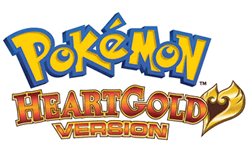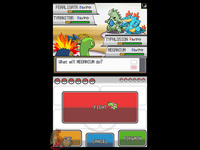|
|

|
PLATFORM
|
DS
|
BATTLE SYSTEM
|

|
INTERACTION
|

|
ORIGINALITY
|

|
STORY
|

|
MUSIC & SOUND
|

|
VISUALS
|

|
CHALLENGE
|
Moderate
|
COMPLETION TIME
|
40-60 Hours
|
|
OVERALL

|
+ Simple battle system with hidden complexity.
+ Plenty of side-quests.
+ Easy multiplayer experience.
- Boring human characters.
- Overabundant random encounter rate.
- Unpleasant dungeon design.
|
Click here for scoring definitions
|
|
|
Brother, can you spare a Snorlax? I have a great idea for the laziest team ever, and all I need are four more of the guys. It will be poignant, it will be killer, and it doesn't even require any legendaries! To be frank, I've had this idea brewing in my head since my first Pokémon experience, which was during eighth grade with Pokémon Red. The system didn't really support what I wanted to do though, so Plan Z has waited, hidden in the mists of nostalgia until I recently put stylus to Pokémon HeartGold. I played Red so much that I must've suffered some kind of burnout; other than a brief, distracted try with Pokémon Emerald, I haven't touched a core Pokémon game since the heyday of the collecting craze. I missed Pokémon Gold, so this retooling of the Game Boy Color's flagship Pokémon game was a fine welcome back, like a phone call from a forgotten friend who occasionally starts screaming for no reason.
Pokémon HeartGold is a grand game for collectors and those who enjoy besting all comers in turn-based combat. Those who require driving plots, believable settings, or exploration of mature themes are advised to stay away. In other words, this is a Pokémon game much like other core Pokémon games: the cookie-cutter protagonist travels from town to town, besting other trainers of strange beasts and winning badges to prove he (or she!) is the very best at pokémon fighting. Despite the similarity to past games in the series, HeartGold demonstrates enough expansion and refinement of the core Pokémon values to be well worth its time and money.
Battle, as in other Pokémon games, is a large element of HeartGold. All pokémon are classified within seventeen different types, including fire, psychic, and steel. Each type has strengths and weaknesses that strongly influence how it fights against other types. For example, psychic pokémonokémon are strong against poison ones. A psychic attack from a well trained level 30 pokémon has a decent chance of knocking out a level 40 poison critter in one hit. Similarly, poison attacks only deal minimal damage against psychic pokémon. Pokémon frequently learn attacks different than their types, and dual-type pokémon help complicate the formula, but it is essentially a very complex paper-scissors-rock formula.
In practice, the battle system shifts between being rigidly trapped by types and celebrating them as a dynamic strategic element. Many situations, especially gym battles, seem like they're downright impossible without a pokémon of the proper type; however, upon training the needed team member, they become cakewalks. On the other hand, designing a team that can respond well to dangers as they arise is a compelling challenge – especially when multiplayer conflicts enter the equation. Battling is not the end all of Pokémon, but it is the most compelling element.
 Goin' for a walk.
Goin' for a walk.
|
|
Rather than featuring a well-developed story, Pokémon features frequent series of obstacles that must be overcome in order to gain access to the next area of the map. For example, in order to get to one gym the player must traverse the Diglett Cave. A sleeping Snorlax blocks the cave, however. In order to wake him up, the player must make friends with a specific man who has a key item. The man won't befriend the player without a favor. Completing the favor involves traveling to several nearby locations and a battle. Chains like this extend throughout the game, often with no guidance beyond the rumors of townsfolk and a vague feeling that a specific direction could be explored further. During the questing process, the player comes into contact with plenty of peace-loving citizens, all of who love pokémon and are willing provide useful, if generic, advice concerning pokémon and pokémon accessories without second thought.
Dungeons, be they caves or towers, are similarly lacking in pizazz. Most are over-stocked with block-pushing puzzles and enemies in a limited number of breeds. Rare is the cave that does not fester with Zubats in need of chemical castration. There are items and pokémon abilities to limit the over-zealous encounter rate, but activating them requires unpleasant micromanaging. The lack of characterization throughout is disappointing; the world has room for more than just blanket cheerfulness.
What Pokémon lacks in characters, it makes up for with its sandbox elements. A straight play of the game will take a little more than forty hours, but that's nowhere near enough time to explore all of the material on the cart. New areas unlock following the accumulation of all of the gym badges, as well as following the second credit roll. In addition, there are plenty of little sidetracks such as pokémon dress-up, a mini-game that combines Minesweeper with Sudoku, fetch quests, an elaborate breeding system, and the Battle Frontier. The Battle Frontier provides ample outlet for post-game, single-player battling needs. Unlike many of the main story battles, these matches follow specific rules that require careful team management to overcome.
The lengthiest side path to walk requires capturing all of the series' titular pokémon. Not all of the wild and willful creatures are available on the HeartGold cart, so obtaining all 493 requires mad trading skills. As a built-in incentive to follow this road, traded pokémon receive bonus experience points after every battle. Wi-Fi trading is quick and easy: all it takes to browse a trading partner's active party of pokémon is a friend code and a simultaneous connection. The Global Trade System (GTS), which allows trainers to trade pokémon with strangers, is a solid idea, but flawed in execution. After visiting the GTS station, players are able to tag their pokémon with trade requirements or search the global pokémon database using a number of parameters such as type, gender, and level. The system responds with three potential trades that match the input parameters. The three choices are limiting, especially given the unbalanced trades that many players have arranged. Perhaps more seriously, the GTS lacks the personal element that makes the game so charming in the first place.
 Run away!
Run away!
|
|
The multiplayer Pokémon experience provides one of the more rewarding endgame scenarios. While most of the battles in the main game can be bested through brute leveling or basic knowledge of the paper-scissors-rock-bug battle system, human opponents are a far cagier bunch. These fleshbound pokemaniacs are the ones who encourage elaborate battle strategies and customization of elite strike teams. The urge to "show people your pokeymanz" plays a strong part in this drive to battle, but the tactics and in-depth formulae are there for those who want them.
The DS's unique control scheme works well with HeartGold's infrastructure. There are a lot of menus to navigate, which are represented in game by large, colorful buttons. Pressing them with the stylus is simple and intuitive. Furthermore, the backpack system for managing one's items provides helpful subcategories so that pulling out the necessary item mid-battle isn't a matter of plowing through one fat list. There's also a "last item used" button, a feature that more games should consider. On the negative side, managing one's non-active pokémon could have been streamlined further, but this is a minor issue compared to the otherwise helpful interface.
HeartGold's graphics and sound consists of updated versions of Gold's. Only a few music tracks are especially memorable, but the sound does not detract from the play experience. The game's graphics are more sympathetic, consisting of brightly colored, cartoony sprites that readily communicate the world's good cheer. Although individual character sprites are a little squashy, they are not the focus; more importantly, cute pokémon radiate cuteness, scary pokémon have the proper number of teeth and protrusions, and plenty are just plain goofy.
Pokémon HeartGold is an addictive game. There's plenty to do and lots of secrets to uncover. Despite the series' many variations on the same theme, the wide-reaching multiplayer aspect enlivens what nostalgia fails to touch. The path of the pokémon trainer is not geared toward loners; among friends, the game's scale multiplies and risks becoming consuming. Even if it's only for a few months, over something as insignificant as battling plant monsters, Pokémon can provide the catalyst for community. This is not an original game, but it is a fun one. The polish and embellishment that Nintendo gave to HeartGold's central elements may not appeal to everyone, but they work. By the way, I'm not kidding about those Snorlaxes.
Review Archives
|









